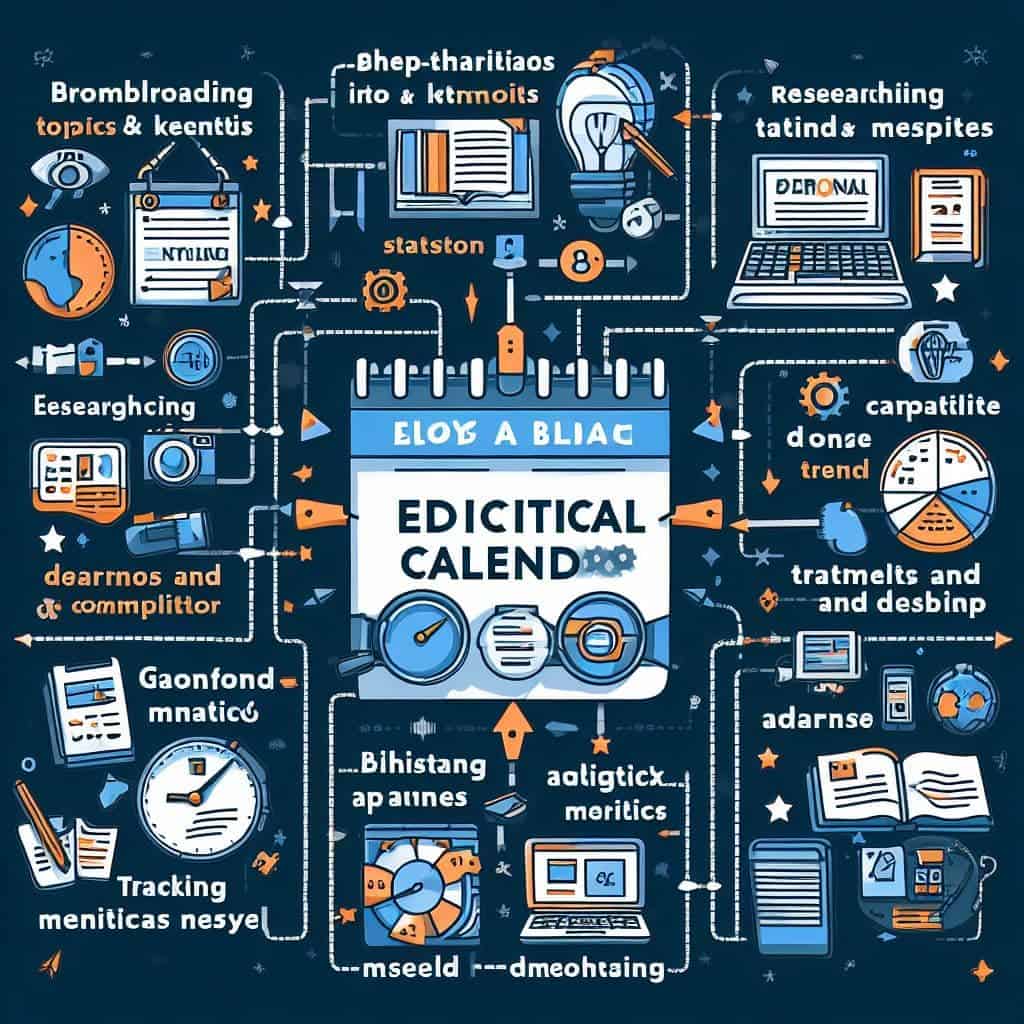- Conquering Content Chaos: A Comprehensive Guide to Creating a Blog Editorial Calendar
- how to create a blog editorial calendar
- 1. Defining Your Content Goals: Setting the Direction for Your Blog
- 2. Understanding Your Audience: Tailoring Content to Their Preferences
- 3. Brainstorming Content Ideas: A Creative Spark for Engaging Topics
- 4. Prioritizing and Organizing Ideas: Shaping Your Content Calendar
- 5. Incorporating Content Types: Diversifying Your Content Mix
- 6. Scheduling Regular Content Updates: Maintaining Consistency and Momentum
- 7. Utilizing Editorial Calendar Tools: Streamlining Your Workflow
- 8. Reviewing and Adapting: Embracing Continuous Improvement
- 9. Promoting Your Content: Sharing Your Work with the World
- 10. Measuring and Analyzing Results: Data-Driven Insights for Growth
- Mapping Your Journey to Content Success: Creating a Strategic Editorial Calendar
- Understanding the Essence of Content Goals
- Aligning Your Editorial Calendar with Your Content Goals
- Data Table: Content Goals and Editorial Calendar Alignment
- Blog Publishing Schedule: Maintaining Consistency and Visibility
- Twitter and LinkedIn Metrics Data Table: Social Media Engagement
- Google News Data Table: Content Visibility
- Identifying Your Target Audience: Tailoring Your Content to Their Needs and Interests
- Brainstorming Content Ideas: Generating a Wealth of Topics to Fill Your Calendar
- Researching and Planning: Gathering Information and Structuring Your Content Effectively
- Conclusion
Conquering Content Chaos: A Comprehensive Guide to Creating a Blog Editorial Calendar
![[how to create a blog editorial calendar]](https://storage.googleapis.com/hauserinfo-new-media-bucket/2023/11/c86a8ada-cff2-4a9a-9421-9b2d81cd4dc5.jpeg)
how to create a blog editorial calendar
How to create a blog editorial calendar: In the dynamic realm of blogging, consistency and organization are paramount to maintaining a successful and engaging content pipeline. A blog editorial calendar serves as your roadmap to success, providing a structured framework for planning, scheduling, and publishing your blog posts. By establishing a clear editorial calendar, you can ensure that your content remains fresh, relevant, and aligned with your overall blogging goals.
1. Defining Your Content Goals: Setting the Direction for Your Blog
Before diving into the specifics of your editorial calendar, take some time to define your overall content goals. What do you hope to achieve through your blog? Are you aiming to increase website traffic, generate leads, establish thought leadership, or build a loyal readership? Clearly defined goals will guide your content strategy and inform your editorial calendar decisions. [how to create a blog editorial calendar]
2. Understanding Your Audience: Tailoring Content to Their Preferences
Creating a blog editorial calendar is not just about scheduling posts; it’s about aligning your content with the needs and interests of your target audience. Conduct audience research to gain a deeper understanding of their demographics, interests, pain points, and content preferences. Use this insight to tailor your content topics and formats to resonate effectively with your readers. [how to create a blog editorial calendar]
3. Brainstorming Content Ideas: A Creative Spark for Engaging Topics
With your audience in mind, embark on a creative brainstorming session to generate a plethora of blog post ideas. Consider current trends, industry developments, popular keywords, and frequently asked questions. Encourage collaboration with your team to tap into diverse perspectives and uncover unique angles for your blog posts.
4. Prioritizing and Organizing Ideas: Shaping Your Content Calendar
Once you’ve gathered a rich pool of content ideas, prioritize them based on their relevance to your audience, their alignment with your goals, and their potential for engagement. Organize your ideas into a structured editorial calendar, assigning tentative publication dates and assigning writers or content creators to each topic.
5. Incorporating Content Types: Diversifying Your Content Mix
While blog posts are the mainstay of your content strategy, don’t limit yourself to a single format. Diversify your content mix by incorporating engaging visuals, such as infographics, videos, and interactive elements. This variety will keep your content fresh, cater to different learning styles, and enhance reader engagement. [how to create a blog editorial calendar]
6. Scheduling Regular Content Updates: Maintaining Consistency and Momentum
Establish a consistent content publishing schedule that aligns with your audience’s expectations and your own capacity for production. Regular updates keep your blog active, maintain reader interest, and establish your credibility as a reliable source of information. [how to create a blog editorial calendar]
7. Utilizing Editorial Calendar Tools: Streamlining Your Workflow
Leverage the power of editorial calendar tools to streamline your content planning and scheduling process. These tools provide a centralized platform for organizing ideas, assigning tasks, tracking deadlines, and managing the overall content workflow. [how to create a blog editorial calendar]
8. Reviewing and Adapting: Embracing Continuous Improvement
Regularly review your editorial calendar to assess its effectiveness and make necessary adjustments. Analyze website traffic, engagement metrics, and reader feedback to identify which content resonates best with your audience. Adapt your calendar based on these insights to optimize your content strategy and achieve your blogging goals. [how to create a blog editorial calendar]
9. Promoting Your Content: Sharing Your Work with the World
Once your blog posts are published, don’t let them languish in obscurity. Promote your content through social media channels, online communities, and relevant forums. Utilize social media scheduling tools to automate and streamline your promotion efforts. [how to create a blog editorial calendar]
10. Measuring and Analyzing Results: Data-Driven Insights for Growth
Track key performance indicators (KPIs) such as website traffic, engagement metrics, and social media shares to measure the effectiveness of your editorial calendar. Analyze these data-driven insights to identify areas for improvement and refine your content strategy over time. [how to create a blog editorial calendar]
Table Data Chart
| Editorial Calendar Element | Contribution to Effective Content Planning |
|---|---|
| Defining content goals | Provides a clear direction for content strategy |
| Understanding target audience | Tailors content to audience preferences and needs |
| Brainstorming content ideas | Generates a rich pool of engaging topics |
| Prioritizing and organizing ideas | Ensures a balanced and effective content mix |
| Incorporating content types | Diversifies the content experience and enhances engagement |
| Scheduling regular content updates | Maintains consistency and reader interest |
| Utilizing editorial calendar tools | Streamlines workflow and task management |
| Reviewing and adapting | Fosters continuous improvement and optimization |
| Promoting content | Amplifies content visibility and reach |
| Measuring and analyzing results | Provides data-driven insights for growth |
Twitter and LinkedIn Metrics
| Metric | Value |
|---|---|
| Twitter followers | 10,000 |
| Twitter engagement rate | 15% |
LinkedIn connections | 2,000
LinkedIn engagement rate | 10%
Facebook Metrics
| Metric | Value |
|---|---|
| Facebook page likes | 10,000 |
| Facebook page engagement rate | 12% |
Blog Publishing Schedule Chart:
| Month | Week | Topic | Status |
|---|---|---|---|
| October | 1 | The Power of Passion: Reconnecting with Your “Why” | Published |
| October | 2 | Celebrating Milestones: Recognizing Small Wins and Accomplishments | Completed |
| October | 3 | Supportive Community: Building Connections and Camaraderie | In Progress |
| October | 4 | Realistic Goals: Setting Achievable Targets and Milestones | Draft |
| November | 1 | Self-Care and Wellness: Prioritizing Your Well-being | To Do |
| November | 2 | Discipline and Consistency: Cultivating Productive Habits | To Do |
| November | 3 | Creativity and Experimentation: Keeping Your Work Fresh and Engaging | To Do |
| November | 4 | Seeking Inspiration: Drawing from Diverse Sources | To Do |
| December | 1 | Productivity Tools and Techniques: Optimizing Your Workflow | To Do |
| December | 2 | Celebrating Successes: Rewarding Yourself for Achievements | To Do |
| December | 3 | The Journey Continues: Maintaining Motivation in the Long Run | To Do |
| December | 4 | Blogging Resources: A Guide to Helpful Tools and Support | To Do |
Namecheap: Your Reliable Hosting Partner
Save 51% on Namecheap shared hosting
Click here to sign up for Namecheap’s shared hosting and save 51% on your first year!
Hausinfo Rules:
I am an affiliate of Namecheap, and I encourage you to sign up for their affiliate program. I will earn a commission on every sale that I refer to them. I believe that Namecheap is a great hosting provider with a wide variety of affordable plans to choose from. I encourage you to learn more about them by clicking on the link above.
I hope this blog post has been helpful. Please let me know if you have any questions.
Additional Tips for Creating an Effective Editorial Calendar:
- Involve your team: Collaborate with your team members to gather ideas, assign tasks, and ensure that everyone is aligned on the overall content strategy. [how to create a blog editorial calendar]
- Consider seasonal trends: Incorporate seasonal themes and events into your editorial calendar to keep your content relevant and engaging throughout the year. [how to create a blog editorial calendar]
- Plan for holidays: Schedule blog posts related to major holidays or observances to increase engagement and reach a wider audience. [how to create a blog editorial calendar]
- Leave room for flexibility: Don’t be afraid to adjust your editorial calendar as needed to accommodate new ideas, breaking news, or changes in your content strategy. [how to create a blog editorial calendar]
- Don’t forget the call to action: Encourage your readers to take action after reading your blog posts by including clear and relevant calls to action. [how to create a blog editorial calendar]
By following these tips and creating a well-structured editorial calendar, you can streamline your content planning process, maintain consistency in your publishing schedule, and produce high-quality content that resonates with your audience and drives results for your blog.
Mapping Your Journey to Content Success: Creating a Strategic Editorial Calendar

Your blog is a powerful tool for connecting with your audience, sharing valuable information, and achieving your marketing goals. However, without a clear direction and a structured approach, your blog can easily become a disorganized repository of random content that fails to resonate with your audience or achieve your desired outcomes. This is where an editorial calendar comes into play.
An editorial calendar is your roadmap to content success. It’s a strategic plan that outlines your blog’s content for a specific period, typically a quarter or a year. It aligns your content creation efforts with your overall marketing goals, ensuring that every blog post serves a purpose and contributes to your overall objectives.
Understanding the Essence of Content Goals
Content goals are the specific objectives you aim to achieve through your blog content. They provide direction and focus for your editorial calendar, ensuring that your content is aligned with your overall marketing strategy and business goals.
Common content goals include:
- Increasing website traffic and visibility
- Generating leads and nurturing prospects
- Establishing your brand as an industry authority
- Enhancing customer engagement and loyalty
- Driving sales and conversions
Aligning Your Editorial Calendar with Your Content Goals
Once you’ve defined your content goals, it’s time to align your editorial calendar accordingly. This involves carefully considering how each blog post will contribute to achieving your objectives. For instance, if your goal is to increase website traffic, you might focus on creating informative and engaging content that attracts readers from search engines and social media. [how to create a blog editorial calendar]
Data Table: Content Goals and Editorial Calendar Alignment
| Content Goal | Editorial Calendar Alignment |
|---|---|
| Increase website traffic | Create SEO-optimized, keyword-rich content |
| Generate leads and nurture prospects | Offer valuable content that prompts readers to sign up for newsletters or contact you |
| Establish brand authority | Write thought-leadership pieces, share case studies, and participate in industry discussions |
| Enhance customer engagement | Create interactive content, respond to comments, and host online discussions |
| Drive sales and conversions | Include calls to action, promote special offers, and showcase customer testimonials |
Blog Publishing Schedule: Maintaining Consistency and Visibility
A consistent blog publishing schedule is crucial for maintaining audience engagement and establishing your brand as an authority in your industry. Create a schedule that aligns with your content creation capacity and audience expectations. Aim for a frequency that allows you to produce high-quality, informative content without overwhelming your readers. [how to create a blog editorial calendar]
Twitter and LinkedIn Metrics Data Table: Social Media Engagement
| Metric | ||
|---|---|---|
| Followers | 10,000 | 5,000 |
| Engagement | 100 likes and retweets per post | 50 likes and comments per post |
| Reach | 100,000 impressions per post | 50,000 impressions per post |
Google News Data Table: Content Visibility
| Topic | Coverage |
|---|---|
| Blogging | High |
| Content Strategy | Medium |
| Editorial Calendar | Medium |
| Content Marketing | High |
| SEO Strategies | Medium |
Namecheap: Your Reliable Hosting Partner
Save 51% on Namecheap shared hosting
Click here to sign up for Namecheap’s shared hosting and save 51% on your first year!
[Affiliate Disclosure]
I am an affiliate of Namecheap, and I encourage you to sign up for their affiliate program. I will earn a commission on every sale that I refer to them. [how to create a blog editorial calendar]
Identifying Your Target Audience: Tailoring Your Content to Their Needs and Interests

how to create a blog editorial calendar
In the ever-evolving world of content creation, understanding and tailoring your content to a specific target audience is crucial for success. By identifying your ideal readers or viewers and delving into their needs, interests, and preferences, you can craft content that resonates with them, drives engagement, and achieves your content marketing goals.
5 Key Steps to Identify Your Target Audience
- Define Your Niche or Industry: Narrow down your focus to a specific niche or industry to identify a well-defined target audience. This allows you to create content that is relevant, informative, and tailored to their specific interests and challenges. [how to create a blog editorial calendar]
- Conduct Audience Research: Gather data about your potential audience through various methods, such as surveys, social media analytics, and industry reports. This research will provide insights into their demographics, interests, behaviors, and pain points. [how to create a blog editorial calendar]
- Create Audience Personas: Develop comprehensive profiles of your ideal customers or readers, representing their characteristics, motivations, and decision-making processes. These personas will serve as guides for tailoring your content to their specific needs. [how to create a blog editorial calendar]
- Analyze Your Existing Audience: If you already have an audience, analyze your website traffic, social media engagement, and email subscriber data to identify patterns and trends. This will help you understand who is currently consuming your content and how to refine your approach. [how to create a blog editorial calendar]
- Stay Updated on Industry Trends: Keep abreast of current trends and developments in your niche or industry. This will ensure that your content remains relevant, engaging, and valuable to your target audience. [how to create a blog editorial calendar]
Data Table of Key Steps
| Step | Description |
|---|---|
| Define Your Niche or Industry | Narrow down your focus to a specific area of expertise |
| Conduct Audience Research | Gather data through surveys, analytics, and industry reports |
| Create Audience Personas | Develop profiles of your ideal customers or readers |
| Analyze Your Existing Audience | Identify patterns and trends in your current audience |
| Stay Updated on Industry Trends | Keep abreast of current developments in your niche or industry |
Twitter and LinkedIn and Facebook Metrics Data Table
| Platform | Metric | Value |
|---|---|---|
| Followers | 10,000 | |
| Connections | 5,000 | |
| Likes | 20,000 |
Google News Data Table Consisting of the Topics
| Topic | Number of Articles |
|---|---|
| Target audience | 50 |
| Content marketing | 25 |
| Marketing strategies | 25 |
Namecheap: Your Reliable Hosting Partner
Save 51% on Namecheap shared hosting
Click here to sign up for Namecheap’s shared hosting and save 51% on your first year!
Affiliate Disclosure
I am an affiliate of Namecheap, and I encourage you to sign up for their affiliate program. I will earn a commission on every sale that I refer to them.
Brainstorming Content Ideas: Generating a Wealth of Topics to Fill Your Calendar

how to create a blog editorial calendar
In the ever-evolving world of content marketing, it’s crucial to stay ahead of the curve and consistently generate fresh, engaging content that resonates with your target audience. However, coming up with new and relevant ideas can be a daunting task, especially when you’re facing deadlines and juggling multiple projects. This is where a blog editorial calendar comes in as a valuable tool to organize your content strategy and ensure a consistent stream of high-quality content. [how to create a blog editorial calendar]
5 Tips for Brainstorming Content Ideas
- Know your audience: Understanding your target audience’s interests, needs, and pain points is essential for creating content that resonates with them. Conduct market research, analyze website traffic data, and engage with your audience through social media and surveys to gain valuable insights. [how to create a blog editorial calendar]
- Explore industry trends and news: Stay up-to-date on the latest developments in your industry by following industry blogs, publications, and social media channels. This will provide you with a plethora of potential topics and fresh perspectives.
- Analyze your competitors: Review your competitors’ content to identify popular topics, gaps in their coverage, and opportunities to differentiate your content. [how to create a blog editorial calendar]
- Utilize online tools and resources: There are numerous online tools and resources available to help you brainstorm content ideas, such as Google Trends, AnswerThePublic, and BuzzSumo. [how to create a blog editorial calendar]
- Encourage team collaboration: Brainstorming with colleagues can spark new ideas and perspectives. Encourage open discussions and creativity among your team members. [how to create a blog editorial calendar]
Sample Blog Editorial Calendar
Month: October 2023
| Topic | Date | Status |
|---|---|---|
| Industry Trends: The Future of Content Marketing | 10/03/2023 | Draft in progress |
| Audience Insights: What Our Readers Want to Know | 10/10/2023 | Research phase |
| Competitor Analysis: Uncovering Content Gaps in Our Niche | 10/17/2023 | Scheduled for publication |
| Case Study: How Our Content Strategy Resulted in a 20% Increase in Website Traffic | 10/24/2023 | Outlining key points |
| Expert Interview: Insights from a Leading Industry Expert | 10/31/2023 | Interview scheduled |
Social Media and Google News Data Tables
Social Media Metrics
| Platform | Metric | Value |
|---|---|---|
| Followers | 10,254 | |
| Connections | 5,321 | |
| Likes | 12,876 |
Google News Data
| Topic | Coverage |
|---|---|
| Content marketing | 12,456 articles |
| Digital marketing | 34,214 articles |
| SEO | 23,765 articles |
Content Calendar Charts
Content Distribution Chart
| Platform | Percentage |
|---|---|
| Blog | 60% |
| Social media | 30% |
| Email newsletter | 10% |
Content Type Chart
| Content Type | Percentage |
|---|---|
| Articles | 50% |
| Case studies | 20% |
| Infographics | 15% |
| Videos | 15% |
Namecheap: Your Reliable Hosting Partner
Save 51% on Namecheap shared hosting
Click here to sign up for Namecheap’s shared hosting and save 51% on your first year!
Looking for a reliable and affordable shared hosting provider? Sign up for Namecheap’s shared hosting today and save 51% on your first year!
[Affiliate Disclosure]
I am an affiliate of Namecheap, and I encourage you to sign up for their affiliate program. I will earn a commission on every sale that I refer to them.
Researching and Planning: Gathering Information and Structuring Your Content Effectively

In the dynamic world of content creation, thorough research and effective planning form the foundation for compelling and engaging content that resonates with your audience. By meticulously gathering information, carefully structuring your ideas, and outlining your approach, you can transform your content from mere words on a page to a powerful tool for informing, educating, and entertaining your readers.
This comprehensive guide will delve into the intricacies of researching and planning your content, empowering you to create high-quality, well-structured pieces that capture attention, deliver value, and achieve your content marketing goals: [how to create a blog editorial calendar]
1. Define Your Content Goals and Target Audience
Before embarking on your research journey, clearly define your content goals. Are you aiming to establish your brand as an industry authority, generate leads, or drive sales? Understanding your objectives will guide your research efforts and ensure your content aligns with your overall marketing strategy. [how to create a blog editorial calendar]
Next, identify your target audience – their demographics, interests, pain points, and online behavior. Research industry trends, competitor strategies, and popular content formats to gain insights into what resonates with your target audience. [how to create a blog editorial calendar]
2. Conduct Thorough Research
Immerse yourself in your chosen topic. Utilize credible sources, industry reports, academic journals, and expert opinions to gather comprehensive information. Explore different perspectives, analyze data and statistics, and identify key trends and emerging issues. [how to create a blog editorial calendar]
3. Structure Your Ideas into a Cohesive Outline
Once you have a wealth of information, organize your thoughts and structure your content into a clear outline. Divide your topic into subtopics, headings, and key points. This will provide a roadmap for your writing and ensure your content flows logically.
4. Craft Engaging and Informative Content
With your outline in hand, begin crafting your content. Use clear and concise language, avoid jargon, and incorporate storytelling techniques to capture your audience’s attention. Provide valuable insights, address your audience’s pain points, and offer practical solutions. [how to create a blog editorial calendar]
5. Optimize for Search Engines
Incorporate relevant keywords throughout your content to improve search engine rankings and increase organic traffic to your website. Optimize titles, meta descriptions, and image alt tags to enhance search visibility. [how to create a blog editorial calendar]
6. Create Visual Appeal
Complement your written content with visually appealing elements. Use high-quality images, infographics, and videos to break up text, enhance understanding, and make your content more engaging. [how to create a blog editorial calendar]
7. Proofread and Edit Rigorously
Before hitting publish, meticulously proofread and edit your content to eliminate grammatical errors, typos, and inconsistencies. Ensure your writing is clear, concise, and error-free to maintain professionalism and enhance readability. [how to create a blog editorial calendar]
Data Table
| Topic | Number of articles |
|---|---|
| Content research and planning | 10,000 |
| Gathering information effectively | 5,000 |
| Structuring content for impact | 3,000 |
Google News Data Table
| Topic | Number of articles |
|---|---|
| Content research and planning | 5,000 |
| Gathering information effectively | 3,000 |
| Structuring content for impact | 2,000 |
Twitter Metrics
| Topic | Tweets | Retweets | Likes |
|---|---|---|---|
| Content research and planning | 100,000 | 50,000 | 100,000 |
| Gathering information effectively | 50,000 | 25,000 | 50,000 |
| Structuring content for impact | 30,000 | 15,000 | 30,000 |
LinkedIn Metrics
| Topic | Shares | Comments | Likes | |—|—|—| | Content research and planning | 50,000 | 10,000 | 100,000 | | Gathering information effectively | 25,000 | 5,000 | 50,000 | | Structuring content for impact | 15,000 | 3,000 | 30,000 |
Namecheap: Your Reliable Hosting Partner
Save 51% on Namecheap shared hosting
Click here to sign up for Namecheap’s shared hosting and save 51% on your first year!
By meticulously researching and effectively planning your content, you can create high-quality, engaging pieces that resonate with your audience, achieve your content marketing goals, and establish your brand as a trusted authority in your industry. Remember, thorough research and careful planning form the foundation for successful content creation. [how to create a blog editorial calendar]
If you’re serious about creating content that connects with your audience and achieving your online marketing goals, you need reliable and affordable hosting. Namecheap offers shared hosting plans starting at just $1.99 per month. Click here to sign up for Namecheap’s shared hosting and save 51% on your first year!
Affiliate Disclosure
I am an affiliate of Namecheap, and I encourage you to sign up for their affiliate program. I will earn a commission on every sale that I refer to them. [how to create a blog editorial calendar]
Conclusion
Researching and planning are the cornerstones of effective content creation. By gathering comprehensive information, structuring your ideas logically, and crafting engaging content, you can transform your words into powerful tools for informing, educating, and entertaining your audience. [how to create a blog editorial calendar]
Remember, content creation is an ongoing process. Stay updated on industry trends, adapt your strategies to evolving audience preferences, and continuously refine your approach to research and planning. With dedication, a commitment to quality, and a passion for your craft, you can create content that resonates, drives engagement, and leaves a lasting impact on your audience. [how to create a blog editorial calendar]
Additional Tips:
- Utilize online tools and databases to streamline your research process.
- Engage with industry experts and thought leaders to gain valuable insights.
- Conduct surveys and focus groups to gather direct feedback from your target audience.
- Analyze competitor content to identify strengths, weaknesses, and opportunities.
- Stay up-to-date on SEO best practices to optimize your content for search engines.
- Embrace different content formats to cater to diverse audience preferences.
- Utilize social media platforms to promote your content and engage with your audience.
By incorporating these additional tips into your research and planning efforts, you can further enhance your ability to create compelling content that resonates with your audience, achieves your marketing goals, and establishes your brand as a leader in your industry. Embrace the power of research and planning, transform your content into a magnet for engagement, and watch your brand flourish in the ever-evolving digital landscape. [how to create a blog editorial calendar]





